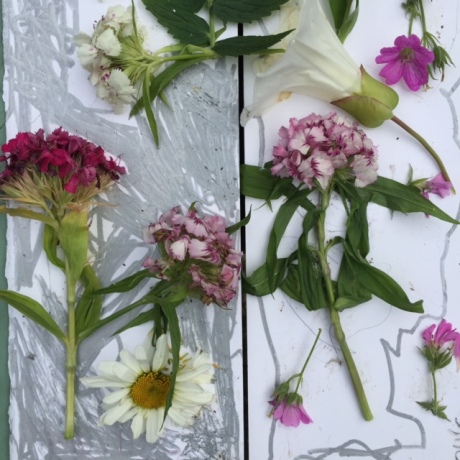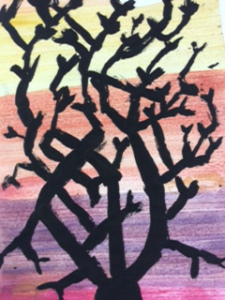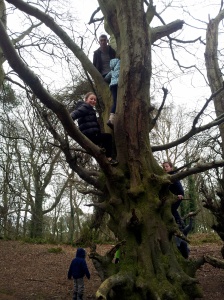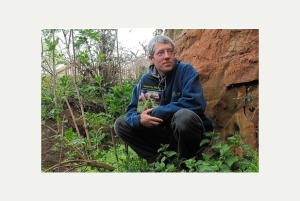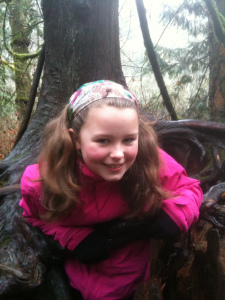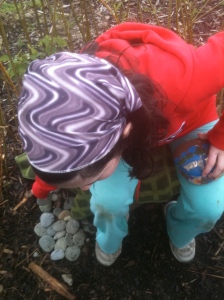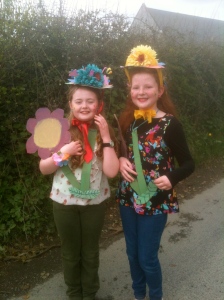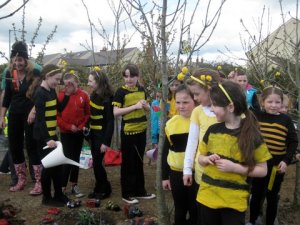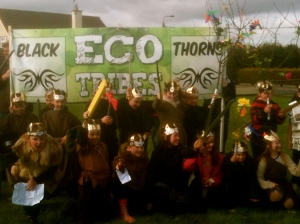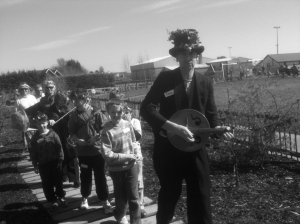The Art Hive at Blackrock Park
July 10, 2018
Photo: Artwork by children in Blackrock Park
The Art Hive movement is an international network of community art studios where everyone is an artist. “It’s a welcoming place to talk, make art and build communities” and “fosters self-directed experiences of creativity, learning, and skill sharing” (www.arthives.org). For more information visit the Art Hive website: http://arthives.org

The Blackrock Park Art Hive is located in Blackrock, County Louth. Blackrock is a traditional seaside village located on the east coast of Ireland.
The Blackrock Park Art Hive is supported by Create Louth: The Arts Service of County Louth, An Táin Arts Centre, Blackrock Park and Blackrock Tidy Towns.


Blackrock Park is a community crafted park, designed and cultivated by hundreds of adults and children who live nearby the park. The gardens in the park are biodiversity and pollinator friendly. There is a forest garden (with edible wild foods), a medieval garden, a Celtic garden, an intergenerational flower garden, a wildflower garden, and a composting education area. These gardens also showcase the artistic and horticultural talents of environmental volunteers and local school children. Three local primary schools have created nature habitats in the park accompanied by pubic celebrations including music, dance, poetry, wild foods, and environmental education.


During the summer of 2018, the Blackrock Park Art Hive will generate outdoor studios for families who will work with natural park materials to make art accompanied by creative writing, spoken word performances and installations within the park environment.

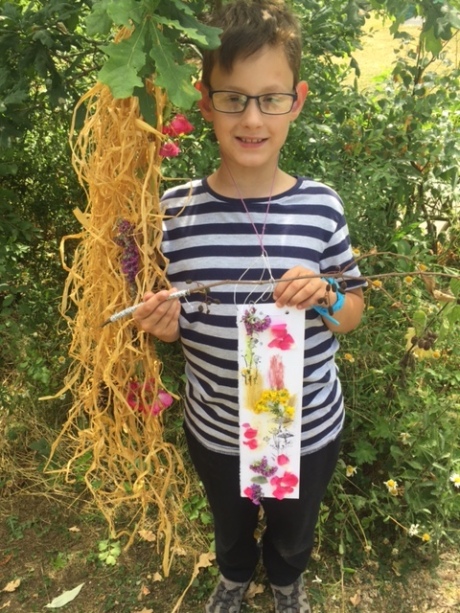
Photos: Children with art works made with flowers, flower pigments and leaf prints

An Táin Arts Centre (Dundalk, County Louth) is a partner of the Art Hive outdoor studio. An Táin families will learn about gardening as an environmental art, creating art with nature, and working within outdoor studios. The goal is to also encourage families to link walks with the foraging of art materials. Ultimately these found and foraged materials will compose the home studio, where each family member contributes their art to the home environment. Working as an artist collective, families will designate a space in their home for the artful exploration of the natural world, their locality, and what is found along the walking routes of their travels together.

Photo: Dried flower Art Hive Display, An Táin Arts Centre, Dundalk, County Louth
Art Projects at the Blackrock Park Art Hive
- Flower Assemblages: Compositions of flowers and displays of flower pigments.
- Flowers for Land Art: Creating larger scale shapes with flowers.
- Biodiversity Print Making: Using leaves and wild plants for prints on paper.
- Lughnasadh Celebration: A community procession to mark the Celtic harvest season with poetry and artworks made with natural materials.

Blackrock Park has been designated pollinator friendly and has developed habitats for solitary bees. Wildflowers and perennial flowers, long grass, clay banks, log piles, and decaying wood are all homes to different varieties of solitary bees. The park’s orchard and soft fruit area directly benefit from these bee habitats, which can be closely observed by park visitors.



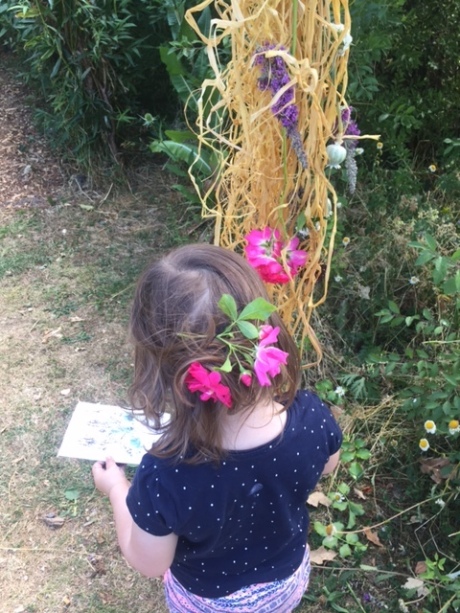
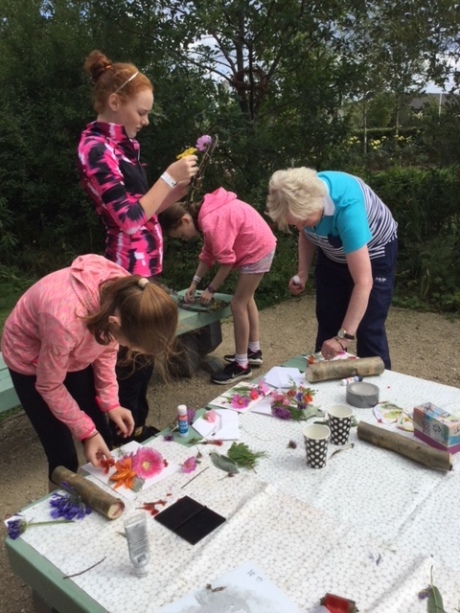
Photos: Participants at the Blackrock Park Art Hive
A Celtic Garden
August 30, 2017
A Celtic Garden was developed by six primary schools in County Louth within their local communities. Each primary school developed a name for their Celtic themed garden and a motto for their project. A public event, was created by each school to celebrate the Celtic season of Bealtaine (connected to the summer growing season).
The children generated festivity through music, drama, dance, poetry, and colourful processions. Local residents, teachers and family members were in attendance and welcomed the addition of a new community garden. Herbal teas, foraged food and traditional Irish dishes were also prepared and the students devised art and educational activities for their guests. The environmental aspect of the project was inspired by Irish garden designer Mary Reynolds and her book The Garden Awakening: Designs to Nurture Our Land and Ourselves.
Mary Reynolds, A Garden for Ceremony
“Create a garden that is alive with the energy and exuberance of nature…With this loving and mutually respectful relationship, you will feel forever supported, grounded and safe…My method of creating a powerfully conscious garden simply suggests using some kind of ceremony to focus your feelings and intentions into a particular form and direction. You can make up your own ritual, as long as you believe it works. Belief is the key.”



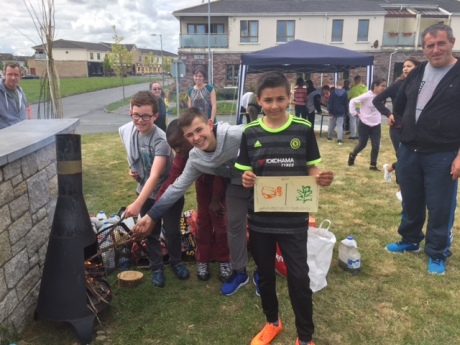

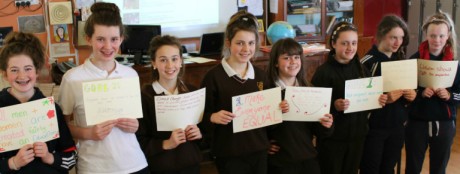
(Photo: UNICEF Ireland, It’s About Us Campaign)
It’s About Us is a workshop for 3rd year student teachers and primary school students on April 7th, 2016 at St Patrick’s College (DCU) in the Quadrangle Courtyard Garden from 11:00 am until 1:00 pm. The workshop is part of a week long storytelling festival at St. Patrick’s College.
The title of the workshop is taken from a UNICEF (Ireland) campaign of the same name https://www.unicef.ie/itsaboutus/ with the slogan “It’s Our World, Let’s Change it Together”. The workshop will be facilitated by Pamela Whitaker of Groundswell, http://www.groundswell.ie who works in the areas of environmental education, arts and health and art therapy.
The theme of the workshop is championing social change. The It’s About Us UNICEF campaign is focussed on children and young people becoming social activists in relation to issues that affect their lives and the lives of their peers throughout the world. “We are voicing our concerns and initiating action, not only to influence the present but also to take responsibility for our shared future” (Dublin Declaration of Children and Youth 2014). The It’s About Us theme will help participants consider social activism as a way to connect their story to the story of others. It offers an introduction to the topic of social campaigning for children and young people.

(Photos: Activate Toolkit, UNICEF)
A key reference in the workshop’s activities is an environmental initiative in County Louth called the Eco Tribes Challenge. The Eco Tribes Challenge encourages primary school children and Tidy Towns volunteers to transform neglected landscapes into biodiversity gardens that not only make nature, but develop community networks of cooperation and inclusion. The Eco Tribes Challenge has been operating for four years and a history of the project can be accessed by searching Eco Tribes or clicking the link: https://mutualgroundtraining.wordpress.com
In 2016 nine schools are involved in the Eco Tribes project each developing a medieval garden (this year’s theme) along with a public event that must enact a community uprising.
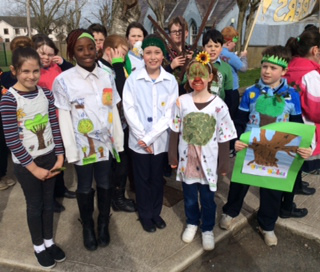
(Photo: The Yew Tubers Eco Tribe, Scoil Bhride NS, Dunleer, County Louth)
Our stories can impact the world. We can begin by talking about our values, beliefs and concerns as a way to develop acts of service that make the world a better place. The Eco Tribes Challenge is one way children are improving the local landscape through gardens that work to bring people together in a crusade to transform environmental apathy. Each Eco Tribe develops an unique identity profile, a tag (a graffiti like signature) and logo to promote both their community garden and environmental activities.
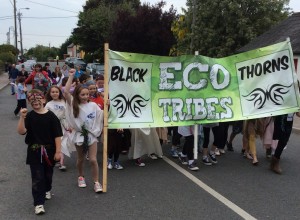

(Photo: An Eco Tribes Challenge Public Event, Dromiskin, County Louth)
During our April 7th workshop we will re-enact some of the activities performed during Eco Tribes public events. We will also make a Protest Garden and try out guerrilla gardening a tactic used by Eco Tribes to fight neglect through unauthorised planting. Each student teacher will work with a primary school student throughout the workshop and develop a partnership based on cooperation, creativity and action.
The workshop will offer an opportunity for participants to explore how it feels to create a public demonstration as a pop-up event.
Preparation for All Participants (Student Teachers and Primary School Students)
All participants must review the It’s About Us UNICEF website http://www.unicef.ie/itsaboutus/
Scroll down the It’s About Us website to view the Global Goals poster, Our Priorities (Issues to Build a Better World as voted by Irish students), the Dublin Declaration on Children and Youth 2014, and most importantly the Profile Cards which highlight young peoples’ stories from around the world through a series of short videos and accompanying discussion cards.
Find a partner and talk about social issues that are important to you both. Share your issues as part of a large group discussion amongst your classmates.
Think about the world around you (your home, community, city, county, country). Discuss how particular social issues relate to your own perspectives, experiences, and views of the world. What plans of action would you both develop to change the world around you?
Each participant must wear a stylised hoodie during the workshop
Each participant’s hoodie can be painted with a particular design, drawn upon with permanent markers, and personalised with trimmings, embellishments or appliqués. A trip to Hickeys (or similar sewing/craft store) will give you ideas regarding how to revamp your hoodie. The designs can relate to graffiti, a nickname, a personal logo, or your overall sense of personal style, etc. The hoodies must be stylised before April 7th and worn to the It’s About Us workshop.
The Art of Trees
May 11, 2015
Photos: Scoil Bhride NS (Dunleer), Tree Procession and Tree Oaths Artwork by students of Scoil Naomh (Muchgrange)
Observing trees and nature can inspire children’s art and creativity. Poetry, song, dance, costumes, drawing, painting and tree dressing all emerge from a feeling of being connected to the natural world. Celebrating trees as part of a procession or special gathering, extends children’s energy and spirit into the larger community. Local residents admire the work of children seeking to make their environments special for everyone. It is the combination of trees, plants and creativity that make these gardens enchanting and engaging.
Photo: St. Peter’s National School, Tree Costumes (Dromiskin)
Children can create tree gardens as dreaming places for the hearts and minds of local communities. Their collective imagination can express the presence and energy of trees within the natural environment, and within the activities of daily life. Gardens created by children are filled with wishes, good intentions and joyful celebration. They accompany the lives of local people as acts of goodwill.
Children’s tree gardens are pubic expressions of art making that help people of all ages connect with the art of nature.
“We learn to impersonate the way nature creates- spontaneously and in relationship. We develop facility with nature’s pattern language. We create and share art in the form of stories, myths, movements, songs and images that give colour, form and life to transformative experiences with the living world. We experience nature as alive with an expression all its own”
(Reference: Bringing Art to Life: Creative Nature Education for Educators by Lisa Lipsett, http://www.creativebynature.org)
Photo: The Art of Baking, Tree Recipes by St. Francis NS, (Blackrock)
Why is Art Important?
1. It’s been proven that early exposure to visual art, music, or drama promotes cognitive activity.
2. Art helps children understand other subjects more clearly—from math and science, to language arts and geography.
3. Art nurtures inventiveness as it engages children in a process that aids in the development of self-esteem, self-discipline, cooperation, and self-motivation.
4. Participating in art activities helps children to gain the tools necessary for understanding human experience, adapting to and respecting others’ ways of working and thinking, developing creative problem-solving skills, and communicating thoughts and ideas in a variety of ways. (Reference http://www.kinderart.com, “Why is Art Education Important”)
Photos: Observational Tree Painting, St. Paul’s NS, (Walshestown) and Ardaghy NS, (Omeath) Playground Orchard Planting Event
Eco Tribes: Herbal Meadows
November 14, 2014
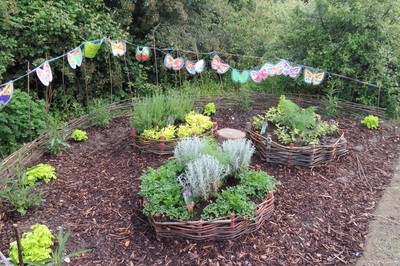

The Eco Tribes projects is an annual challenge whereby primary schools work as gangs of guerrilla gardeners transforming neglected areas of land within their local communities. Every year a different planting theme is chosen to inspire biodiversity and ecological gardening methods. The cultivation theme for 2014 was Herbal Meadows.
Each primary schools selects a unique name and symbolic tag to brand their tribe. The name of each guerrilla gardening group must be of an Irish tree, wild flower, plant or herb (i.e. The Blackthorns or The Honeysuckles). The primary schools work in close collaboration with local volunteers, school teachers and family members to promote biodiversity and landscape sustainability.
The highlight of the project is the public event organised by each school, which can take the form of a parade, outdoor music concert, traditional market, community poetry reading, folklore presentation, historical tour, or outdoor rave. The goal of each public event is environmental education and the promotion of biodiversity within village settings. Rather than solely a conservation issue, biodiversity can be a creative assembling of flowers and herbs that reflect the unique natural and social history of each locality. Many local wild plants were traditionally used for healing purposes at both a personal and community level. In the latter case, seasonal celebrations evoked the use of specific plants for rituals pertaining to the different stages of the growing year.
A Herbal Meadow is composed of both medicinal and culinary herbs, and integrates visually into local rural communities surrounded by fields and hedgerows. The Herbal Meadow blends traditional cures, wild foods, and aesthetic features to produce a complex arrangement of beneficial plants that craft ecological habitats. The gardens also act as meeting points, and places where children have redesigned their surroundings to suit themselves.
The Forest Classroom
April 7, 2014
Chris Holland is a environmental educator based in the UK. His book I Love My World is an exploration of creative activities for children to pursue in the context of forest schools.
Forest schools promote ecological learning, integrating bushcraft, environmental awareness, teamwork and personal development. Children are encouraged to make fires without matches, to identify edible plants, to carve wood, to build shelters and to collaborate on learning survival skills within forest school outdoor classrooms.
In Ireland Earth Force Education (www.earthforceeducation.com) is delivering forest school experiences to children in the context of school holiday camps, and offering training to adults interested in becoming forest school teachers. Children become exposed not only to natural habitats and changing weather conditions, but the capabilities and strengths they have within. Forest school learning is not segmented, but flows through a course of activities that teach each child how to live in relationship to the natural world.
Forest schools are an art form in themselves, creating camp like classrooms with shelters interwoven with branches and integrating features of the landscape. Environmental educations is not a subject, but a way of living, a beckoning into science, folklore, seasonal traditions, and storytelling. Chris Holland’s Forest School training includes “nature awareness, ways of making fire by friction, shelter making, knife, axe and pruning saw use, tracking, woodland bling and garden jewelery, wild food and wild medicine, campfire cookery, coppicing and rural skills as well as some storytelling activities for would-be storytellers” (Chris Holland, Wholeland Website http://www.wholeland.org.uk/for-training).
A Photo of Chris Holland with his book I Love My World.
Natural Escape Routes for Children
November 29, 2013
An empathy with the natural world can become a vital part of children’s psyches; they will learn to take nothing for granted, and will continually probe and ponder. They will have a sense of wonder and mystery about the world around them; it will become a vibrant part of their consciousness…In short, they will feel committed and responsible for the world in which they have been placed as caretakers for a brief moment of time (Paddy Madden, Go Wild at School).
The following is a summary of some of these research findings.
1. Nature enhances children’s skills in the following areas –
Problem Solving, Teamwork, Experimentation, Decision-Making, Adaptability, Confidence, Enhanced Communication, Sensory Development, Intellectual Stimulation (Carol Duffy, Childhood Specialist, Ireland)
2. Recent research proposes that exposure to the outdoors reduces anxiety, and enhances learning. (Dr. Dorothy Matthews, American Society for Microbiology)
3. “A den (made from natural materials) is the child’s sense of self being born, a chance to create a home away from home that becomes a manifestation of who they are. The den is the chrysalis out of which the butterfly is born.” (David Sobel, Antioch New England Graduate School)
4. “By bolstering children’s attention resources, green spaces may enable children to think more clearly and cope more effectively with life stress”. Engagement with natural settings has been linked to a child’s ability to focus, and enhances cognitive abilities. Nearby nature is a buffer for anxiety and adversity in children. (Dr Nancy Wells, Cornell University, New York)
5. The outdoor environment enhances the understanding of social relationships, language, physical movement, reasoning, curiosity, and the capacity to imagine possibilities. (Jane Williams-Siegfredsen, Viborg University College, Denmark)
6. Fostering children’s identity to include personal and social relationships with nature, improves their empathy and sense of inter-connection with the world-at-large. (Anita Barrows, Clinical Psychologist, Berkeley, California)
7. Nature can activate sensory, emotional, cognitive, symbolic and creative levels of human experience through de-familiarisation. Taken for granted everyday things, are sensitively given new meaning and enhance a child’s capacity to perceive. (Jan Van Boeckel, Research Fellow Aalto University Helsinki, Anthropologist, Filmmaker)
8. “Involuntary attention, as opposed to directed attention, can be cultivated within nature”. The “soft fascination” of the natural world can restore focussed attention required for directed studies. Involuntary attention is achieved without effort by simply observing what captures our attention. Our mind wanders and takes a rest from concentrated effort, which in turn improves learning. (Marc Berman, Brain Scientist, University of Michigan)
References
Paddy Madden, Go Wild at School
Children and Nature Network childrenandnature.org
Nature Art Education http://www.naturearteducation.org
A Blooming Uprising: Primary School Activists
May 9, 2013
Eco Tribes is an initiative supported by Louth County Council, which encouraged ten primary schools in County Louth to create nature friendly gardens within their communities. The students celebrated the European Year of Citizens by becoming environmental activists. They learned about garden design, how to organise community celebrations, and gardening for bees and butterflies. They also collaborated with their local Tidy Towns group to transform a neglected piece of land into a garden. Each school performed music, drama, dance, poetry, or song for their public celebration.
A garden can be a public landmark within a community. A source of pride for children, who demonstrated high levels of teamwork, organic gardening skills, creativity and performance skills.
Their research, highlighting the decline of bees and butterflies within Ireland, has also demonstrated the importance of planting cottage garden flowers, herbs, and wildflowers.
The Eco Tribes project has raised the profile of Green Schools within their communities. Their inter-generational collaboration with adults working to revive their localities, has inspired a new generation of community minded volunteers.
Eco Tribes: Guerrilla Gardening with Green Schools
February 19, 2013
Eco Tribes: The Biodiversity Challenge is supported by Louth County Council, Environment Section and the Department of the Environment, Community and Local Government.
The project will mark the European Year of Citizens 2013, by promoting active citizenship and intergenerational social activism.
Collectively the Eco Tribes will enact A Bloomin Uprising in County Louth, as they transform neglected areas of land within their local communities, into habitats for bees and butterflies.
The project also involves a media and public education event, where students will encourage their communities to cultivate flowers for bees and butterflies. Each school’s Eco Tribe will develop a ‘tag’ for their group, in the form of a name and symbol representing a native Irish tree, wildflower or plant.
Besides crafting biodiversity gardens, and learning the tactics of guerrilla gardening, students will be empowered to think about strategies to implement social change at a community level. Environmental activism encourages children to evaluate their local landscape, in order to generate goals for their campaign. The Eco Tribes projects cultivates a sense of empowerment, strategic thinking, team work and creative expression. It puts children at the forefront of social change within their communities.
Natural Relations: Arts and Health
September 6, 2012
 A summer long residency at Ferdia House Ardee (part of Moorehall Healthcare for older people), worked to develop an arts studio adjacent to the dining area of Moorehall Retirement Village. The project incorporated botanical drawing, fibre arts, poetry, photography, print making, crocheted shapes and sewn images. Herbal tonics were prepared and shared at the end of each session, linking the art project to herbs growing in gardens located outside of Ferdia House.
A summer long residency at Ferdia House Ardee (part of Moorehall Healthcare for older people), worked to develop an arts studio adjacent to the dining area of Moorehall Retirement Village. The project incorporated botanical drawing, fibre arts, poetry, photography, print making, crocheted shapes and sewn images. Herbal tonics were prepared and shared at the end of each session, linking the art project to herbs growing in gardens located outside of Ferdia House.
The display of artworks grew progressively throughout the sessions, and are now displayed within windows and suspended as floating botanical forms. Magnified seeds, root shapes and plant cells were the prevailing forms of artistic inquiry for the project.
Participants said they were impressed with the many ways they worked with different kinds of art materials. They particularly enjoyed using a small microscope for observing plant cells. Ferdia House Manager, Breege Conlon said “It’s art at many levels, a holistic approach where people can participate at whatever level they can. The idea of the studio is important, as people can come and go when they want to, and explore different kinds of materials and ways of looking at art.”


